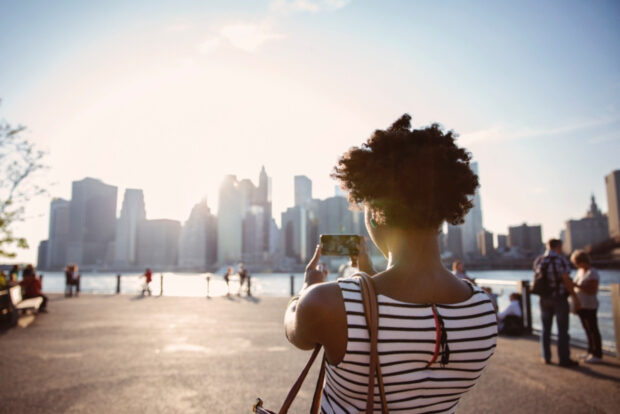When COVID-19 hit and countries moved to close borders to protect their populations, the tourism industry shut down almost overnight, with big implications for the economy. Now countries have reopened, governments have a part to play in getting tourism back on its feet and making it more resilient to future shocks. At a Mastercard webinar, experts in the Asia Pacific region spoke about government intervention, the digitalisation of the industry, the increasingly environmentally aware traveller, and the challenge of staff shortages
The tourism industry has always been particularly vulnerable to geopolitical events, recessions and – as we’ve seen in the last three years – global health pandemics. COVID brought the industry to its knees but as it begins to get back on its feet, governments and operators are taking the lessons learnt during that devastating period and looking at ways to reboot tourism for a new age.
At a Mastercard webinar, public and private sector experts in Australia, New Zealand and the Philippines discussed how the pandemic prompted governments to look afresh at how they support the tourism industry, and new approaches to making it more sustainable, inclusive, and resilient.
Nick Jones, executive director, destination development at the South Australian Tourism Commission began by explaining that his organisation had set a target of doubling tourism expenditure in the state to AUS$8bn (US$5bn) by 2020. In December 2019, it reached its goal. “Things were looking fantastic, airlines were growing, tourists were flying in from around the world. And then we got to 2020 and we know what happened – it fell off a cliff.”
Fast forward to now and Jones said South Australia has seen all-time record accommodation figures across the state and over 70% occupancy at its Central Business District hotels – among the highest rates in Australasia. “We can sit here today and say things are looking really bright and we’re positive about the future,” he said. But that isn’t to say it hasn’t been a long, hard slog.
An early focus on domestic

When the pandemic hit there were 18,000 businesses in South Australia alone that were in danger of going bust, forcing the government to step in.
Given COVID restrictions meant people couldn’t cross domestic borders, the Commission’s initial focus was to promote intrastate tourism. It rolled out eight rounds of its Great State Voucher, giving citizens up to AUS$100 (US$63) towards a hotel stay and up to AUS$200 (US$126) towards tours and experiences. Average spend resulted in a five-to-one return and enabled tourism businesses to retain staff so they could “power up more quickly” when borders began opening up. “It was hugely successful. It bought us time to keep the dollars flowing,” Jones said.
Like in Australia, whenever New Zealand came out of lockdown, “domestic tourism went off” according to David Perks, general manager – Tākina Commercial Development at Wellington City Council. “We saw New Zealanders travelling like they never had before”.
As such, Tourism New Zealand pivoted its spend into the domestic market whilst the federal government diverted NZ$100m (US$57m) to regional tourism organisations – using them as an interface to support local businesses and help replace international visitor spend – and allocated a more substantial NZ$400m (US$228m) to ensuring that when visitors did return, “attractions were still open and able to offer an amazing experience,” Perks said.
He explained that one of the outcomes of the investment into regional tourism organisations was that the delivery of ‘destination management plans’ would – at the expectation of central government – feed into local governments’ overarching long-term plans and be incorporated by transport and conservation agencies and other relevant departments.
‘Digital is the lifeline of tourism’
The government of the Philippines prioritised support for the tourism industry with the implementation of the Tourism Response and Recovery Plan (TRRP), first introduced in 2020.

As Ramil Basuel, chief tourism operations officer, Tourism Development Planning Division, at the Philippines’ Department of Tourism explained, there were three main challenges to keeping the country’s travel sector alive. One, it comprises primarily micro- and medium-sized businesses that didn’t have the capital to support their operations when restrictions were in place; two, inconsistent local government protocols and the lack of a clear reopening roadmap made it difficult to promote destinations to visitors; and three, many operators didn’t have the funds or network access to enable them to shift to digital platforms or to digitalise their processes.
“We’re not there yet,” Basuel said of overcoming the latter hurdle. But the country has seen progress. During the pandemic, some operators created online dashboards so that visitors could view accommodation, transportation options and tours all in one place. “The next step for us is to continue to invest in online solutions that integrate booking and payments as well,” he said.
The Philippines’ experience fed into a discussion about the digitalisation of the tourism industry and how a well-managed and effective transition – supported by governments and the private sector – could drive greater inclusion.
Asha Cugati, vice president, government and B2B vertical, Mastercard ANZ, explained how Mastercard had supported governments and businesses around the world, having worked through the pandemic on more than 1,000 initiatives in over 60 countries.
“Much of our ability to support governments has to do with the shift to digital and the pandemic has of course accelerated that in the past two years,” Cugati said. “We’ve seen more digitisation across payments and customer experiences in the past two years than we have in the past decade.”

She explained that a focus of Mastercard’s work with the tourism industry is inclusion. “We know women, young people and small businesses make up the majority of the tourism ecosystem and that because of the downturn, these groups and individuals have been disproportionately impacted,” she said.
To help remedy this, Mastercard partnered with the UN World Tourism Organization on the Digital Futures Programme through which it supports SMEs to become digital.
“We’ve seen evidence that small businesses that digitised during the pandemic saw a 5% uplift in sales revenue versus pre-pandemic levels,” Cugati said. “It’s absolutely critical. If you don’t have a digital presence, then it’s very difficult to attract customers.”
Read more: Flight path to recovery: how technology can help tourism SMEs bounce back post-pandemic
This sentiment was echoed by Jan Hutton, chief executive officer of the Australian Tourism Data Warehouse. “Digital is the lifeline of tourism. Without online visibility, you simply don’t exist,” she said. “It’s critical that digital accelerates accessibility in a democratised way to get the industry cohesively online and with the right capabilities. The industry is made up of a lot of small business owners and sole traders who often don’t have the capacity.”
The Australian Tourism Data Warehouse (ATDW) has, she said, “worked hard over the last few years to increase the digital maturity of those in our industry”. A digital tool in itself, the tourism marketplace lists around 65,000 products (including accommodation, attractions, events and tours) and 250,000 distributors.

According to Hutton, the ATDW – which channels bookings to the businesses on its site while working to give them greater visibility and exposure both domestically and internationally – was a major boon during the pandemic. She said it “played a really significant role” in rolling COVID safe plans out to the industry whilst providing consumers with verified information about the products and businesses that were open and available. Between 2020 and 2022, it delivered 12 million leads to its clients.
“The way we rallied together I think was unique and a credit to the relationships and communication across the states,” Hutton said. “It was far from perfect and there were many lessons learned but there was a lot we did right.”
As well as its own digital transformation, which involves rebuilding the entire platform, the focus for the ATDW is its data strategy, which in turn feeds into the tourism industry’s national recovery programme. “We’re using our first party data to look at our audiences and distribution and understand how we optimise conversion, because that’s what it’s really all about – maximising yield,” Hutton explained.
Solutions to staff shortages
Another pressing issue for the sector, shared across borders, is the problem of staff shortages. Tourism workers were forced, or chose, to leave the industry in droves as a result of the chaos caused by COVID – and many haven’t returned.
“Staffing is the challenge. People have moved on. They’ve found something more solid – 9 to 5, five days a week,” South Australia’s Jones said. “Pre-COVID in travel agents for example, there were too many staff, not enough customers. Now there are too many customers and not enough staff. There is immense demand at the moment.”
He said that to attract people back to the industry, it needed to offer benefits akin to other sectors and to address seasonality. “It can’t be this AUS$15-an-hour cleaning job five hours a day – it’s got to actually provide benefits and the stability to become a career. If tourism is to be a serious sector, we’re going to have to pay more and that will ultimately mean the consumer will pay more for the experience,” he said.
The ATDW’s Hutton agreed that on top of the industry’s volatility, working long hours for comparatively low pay had put people off.
When a significant workforce shortage became apparent, the ATDW was able to act quickly, facilitating recruitment by adding a job vacancy badge to business profiles. But longer term, in Hutton’s opinion, the way to attract people to the industry is to provide a development pathway for young people that will lead them to a career in tourism. “We’ve got to start professionalising it. And I do think that institutions are raising the bar,” she said.
An urgent priority for the sector should be to attract workers who have recently left the industry back, Basuel said. The Philippines government is working to do that through incentivisation, in part through offering opportunities to upskill.
The traveller of the future – environmentally aware
Talk among the webinar panellists turned to what the traveller of the future might want and expect – and, aside from the convenience of digital service, all agreed that sustainability is becoming front and centre for tourists.
Jones said that increasingly, travellers are aware of the impact travel has on the destinations they visit and have an expectation that countries are “doing the right thing” when it comes to manging the environment and protecting wildlife. As a result, he said off-grid solar accommodation is beginning to emerge and will likely become the norm as people seek “guilt-free tourism”.
He pointed to the South Australian Tourism Commission’s AUS$20m (US$13m) tourism industry development fund, which was allocated early on in the pandemic to pay for refurbishing old and building new accommodation and tourism experiences, and to save construction jobs. Sustainability was a “non-negotiable” requirement of any funding application, encouraging the take-up of renewable energy. “I think a real challenge is going to be finding that balance between sustainable tourism and economic needs and providing job creation. In some areas, more tourism is not always best,” he said.
In New Zealand, Perks explained that the pandemic sped up the work described in the country’s 2019 tourism strategy, which aims to increase productivity in the tourism sector; ensure visitors have an exceptional experience; build thriving sustainable regions; protect, champion and restore the natural and cultural heritage of the country; and make sure New Zealanders’ lives are improved by the tourism industry – a key part of current government strategy to ensure everything is looked at through a wellbeing lens.

Now that international visitors are coming back to country, the government has set in motion an industry transformation plan looking not only at workforce adaptation for climate change but also at how the tourism ecosystem is funded.
The government has recognised that “a lot of the architecture of the tourism system and New Zealand government, both central and local, is very much economy and volume based,” Perks said. What it is doing now, he explained, is to “make sure that when we’re examining the success of what we do, we’re actually looking at the impact on our environment, and the impact and opportunity that’s provided societally to New Zealanders”.
Likewise the ATDW is, through partners such as Eco-tourism Australia and Earthcheck, rolling out scorecards to help the industry raise the maturity of sustainability and “make sure that we are ready for that more conscious consumer as things start to build back,” said Hutton.
She added: “Sustainability was important to us before COVID but it is now so much more than just some carbon neutral target – it is a much more engaged strategy that is looking to drive carbon neutral behaviours, which are vital. And it’s also very much about preparation for the future, in a climate changing world that is volatile.”
Upturns and downturns
Building a more resilient tourism industry isn’t limited to sustainable policies. More immediately, as one of the webinar’s audience members pointed out, the tourism industry will have to face up to the prospect of rising inflation and economic downturns impacting its bottom line.
“Disposable income is being eroded due to the cost of living and that absolutely does cause people to reprioritise how they spend it. Tourism is still seen very much as a luxury so there is an anticipation that that will impact visitation,” Hutton said.
Though the travel vouchers offered to Australians during the pandemic were a short-term “band aid”, Hutton said the industry is recalibrating pricing strategies and “continuing that mindset of making sure that we are absolutely offering as much value for money as possible”.
For now, Jones is positive. He said that despite the doom and gloom around inflation, people have only recently been let free after years of restrictions and lockdowns and that as a result, they’re prioritising travel. “As things become more challenging and food and power costs rise, whether travel can maintain that level of demand, we’ll have to see,” he said. His advice is not to lose sight of the domestic tourist. “If we can get people to travel to a caravan park in the same state and have a great family experience, that will support some jobs.”
Mastercard’s Cugati agreed with Jones that for now, the slow recovery does not reflect demand, citing transactional data which shows that restaurants, airlines and lodgings in the Asia Pacific region saw double digit spent growth over the first half of 2022.
“As the industry rebounds, we have an opportunity to work together towards a more sustainable, resilient and inclusive tourism industry. It’s really a chance to rethink tourism,” she concluded.
The webinar Open for business: how government can help reboot tourism post-COVID was hosted by Mastercard on 28 September, with support from Global Government Forum. You can watch the 75-minute webinar via our dedicated event page.










